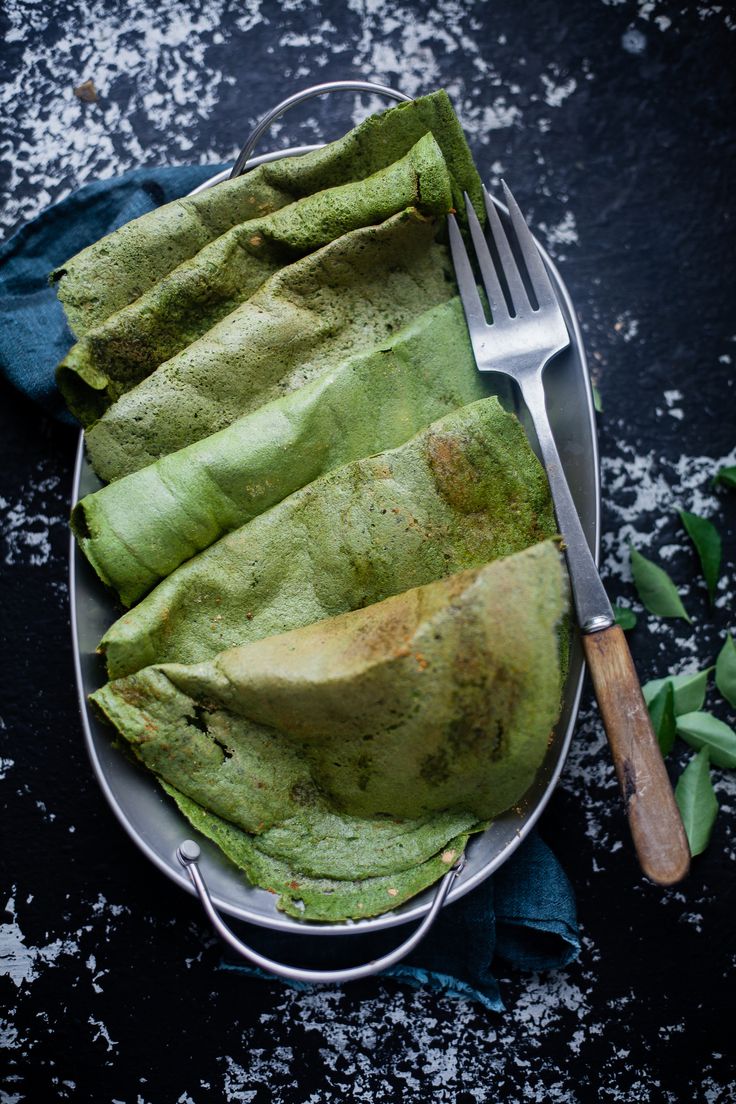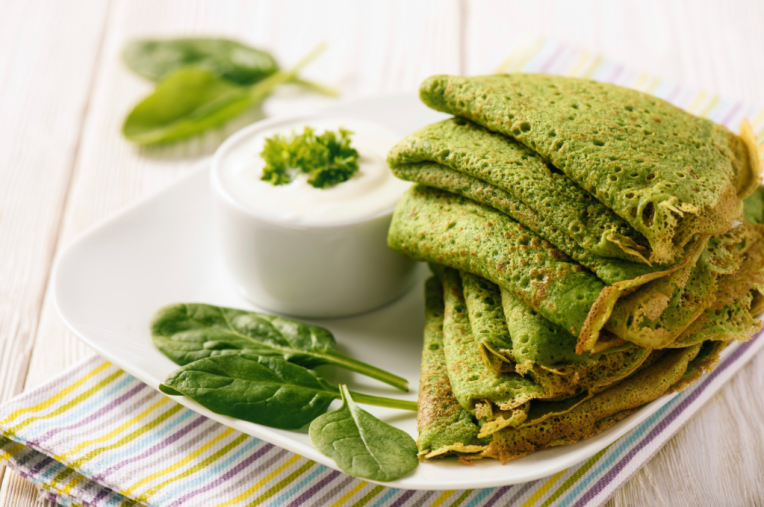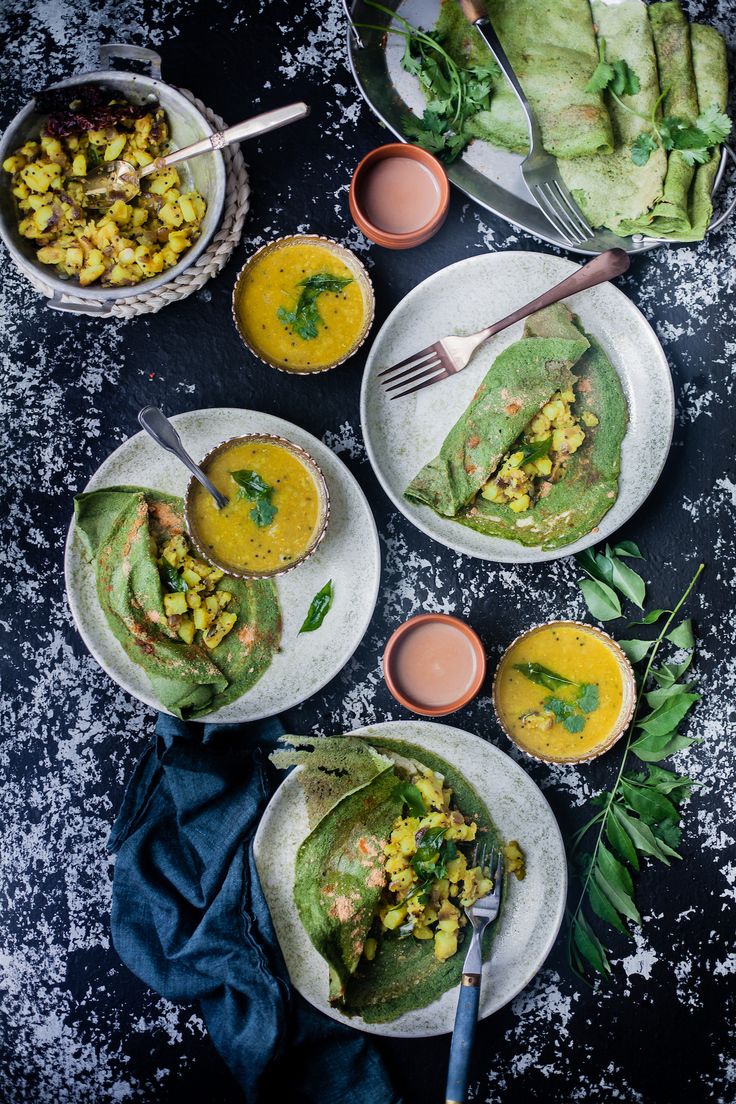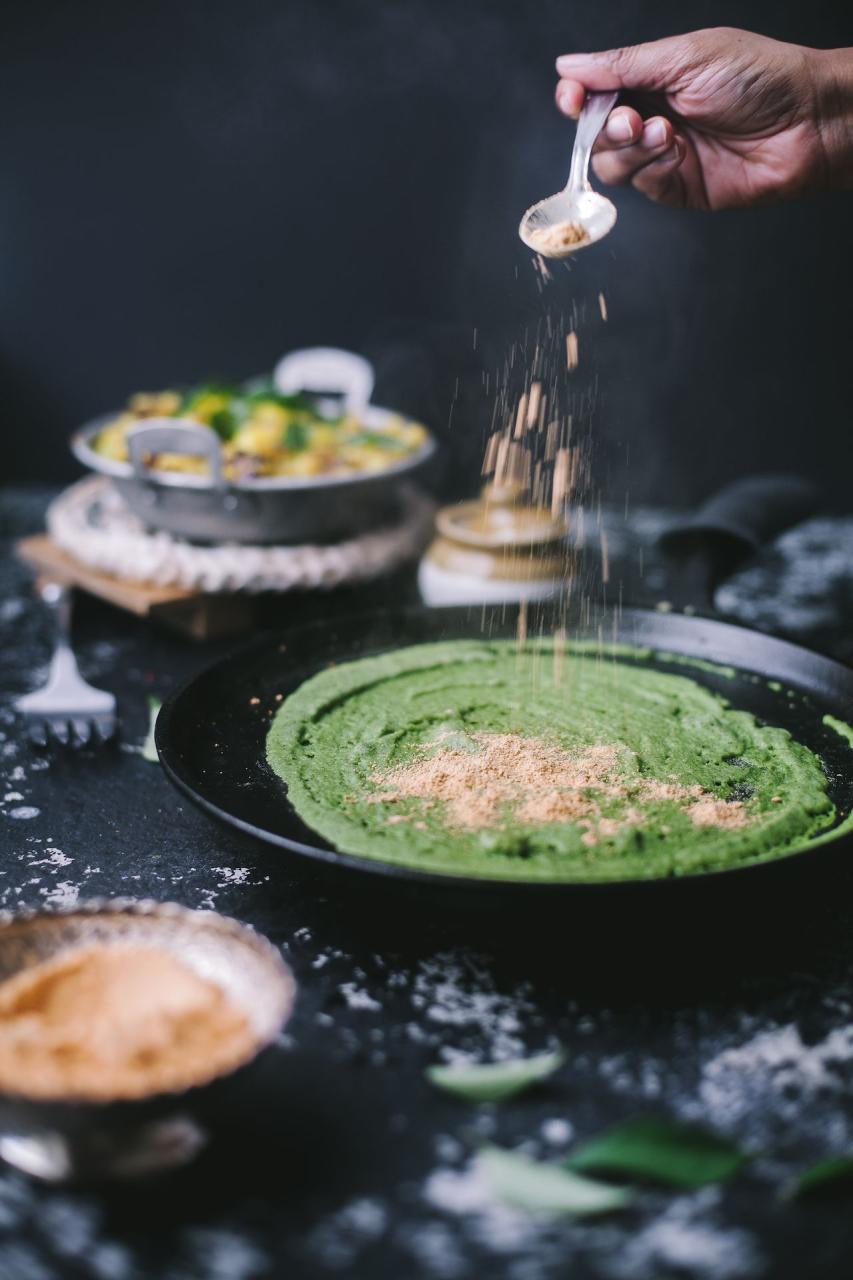Pesarattu, often hailed as the emerald jewel among the diverse array of Indian crêpes, is more than just a breakfast delicacy from the southeastern state of Andhra Pradesh—it’s a testament to the varied palette of Indian cuisine. This green mung bean crêpe warmly unfolds on your plate like the first leaves of spring, bringing with it a vibrant blend of health and flavor.
Crafted from a batter of soaked and ground whole green gram, Pesarattu stands apart with its unique color and texture, a welcome departure from the more familiar hues of dosas. Each crêpe is a canvas that narrates the tale of wholesome goodness and traditional culinary wisdom, seamlessly adapting ancient food practices for today’s discerning palate.
The beauty of Pesarattu lies not only in its rich, verdant hue, which promises a refreshing start to any morning but also in the rich proteins and fibers packed within, making it an ideal choice for those seeking nourishment without compromise on taste. It’s crisp at the edges, yet softly firm in its body, whispering tales of fields waving with mung beans under the boundless, sun-washed sky.
Pesarattu Green Mung Bean Crêpes Recipe


Pesarattu Green Mung Bean Crêpes
Equipment
- 1 large bowl
- 1 small bowl
Ingredients
- 1 cup green mung beans rinsed at least twice in cool water, drained well
- 1 tablespoon idli rice rinsed at least twice in cool water, drained well
- 1 tablespoon husked whole black lentils rinsed at least twice in cool water, drained well
- 2 teaspoons finely chopped peeled fresh ginger
- 2 green chiles finely chopped
- 11/2 teaspoons salt
- 11/2 cups water
- 1/2 cup finely chopped onion
- 1/4 cup finely chopped fresh cilantro
- 10 teaspoons vegetable or corn oil divided
- Ginger Chutney for serving
Instructions
- In a large bowl, combine the green mung beans, rice, and black lentils and add enough cold water to cover by 2 to 3 inches. Let soak at room temperature for 6 to 8 hours.
- Drain the mung beans, rice, and lentils and transfer to a blender. Add the ginger, green chiles, and salt and pulse the blender a few times to grind. With the blender running, slowly pour in the water (I use the entire amount) until you have a smooth batter.
- In a small bowl, stir together the onion and cilantro.
- Heat a cast iron griddle or nonstick griddle over medium heat.
- Reduce the heat to low and pour a ladleful of batter onto the griddle. Using the back of the ladle, spread the batter around the griddle, starting from the middle and moving out toward the edges.
- Spread 1 teaspoon of oil around the edges of the pesarattu. Sprinkle some onion and cilantro on the top of the batter. Increase the heat to medium and cook the dosa for 60 to 80 seconds. The color on the top of the crêpe will change to a pale green. Using a spatula, loosen the edges of the crêpe and carefully flip it. Cook for 30 to 40 seconds more. Transfer the crêpe to a plate. If any of the onion falls off, place it back on top.
- Repeat with the remaining batter, oil, and onion and cilantro topping. Serve hot with ginger chutney.
Notes
Cooking Tips about Pesarattu Green Mung Bean Crêpes

- Quality of Mung Beans: Opt for high-quality whole green gram (mung beans), which is the critical ingredient for Pesarattu. Fresh, unspoiled beans ensure a better taste and texture.
- Soaking is Key: The beans should be soaked overnight or at least for 6-8 hours. Proper soaking allows the beans to blend into a smooth batter, which is essential for the right consistency.
- Grinding Matters: When grinding the soaked beans, add just enough water to facilitate the process. Aim for a fine mixture; too much water will thin out the batter excessively, while too little won’t grind the beans properly.
- Consistency: The batter should be slightly coarse and of pourable consistency but not as thin as Neer Dosa batter. It should easily spread on a pan without tearing.
- No Fermentation Needed: Unlike other dosa varieties, Pesarattu does not require fermentation. Once the batter is ready, it can be used immediately.
- Seasoning the Batter: Enhance the flavor profile by adding finely chopped ginger, green chilies, cumin, and salt into the batter. These ingredients give Pesarattu its distinctive taste.
- Hot Pan: The pan or griddle should be at medium-high heat when you pour the batter. A properly heated pan ensures even cooking and crisping at the edges.
- Oil for Crisp Edges: Drizzle a bit of oil around the edges after spreading the batter. This helps in achieving those wonderfully crisp edges that Pesarattu is famous for.
- Toppings: For added texture and flavor, sprinkle finely chopped onions, green chilies, and fresh coriander on the batter before it fully sets on the pan. Press them gently with a spatula.
- Cooking Till Just Right: Allow to cook until the top appears dry, then flip to cook the other side to a light golden-brown color. Be careful not to overcook, as Pesarattu should have a balance between crisp and soft textures.
Serving suggestions about Pesarattu Green Mung Bean Crêpes

- Ginger Chutney: A tangy and slightly spicy ginger chutney complements the earthen tones of Pesarattu, enhancing the taste with its bold flavor profile.
- Coconut Chutney: For a smoother and more soothing companion, coconut chutney with its creamy essence works like a charm against the crisp texture of the crêpes.
- Tamarind Chutney: If you’re seeking balance between sweet, tart, and savory, tamarind chutney can be a perfect match for the hearty Pesarattu.
- Sambar: While not as common a pairing as the chutneys mentioned, a bowl of warm sambar with its medley of vegetables and lentils can turn Pesarattu into a more filling meal.
- Upma: Sometimes, Pesarattu is served with a scoop of Upma (savory semolina porridge) rolled inside, which adds a dimension of texture and satiates hunger for longer periods.
- Freshly Sliced Vegetables: Simple freshly sliced vegetables such as cucumber or carrot sticks can bring a refreshing crunch that juxtaposes delightfully with the Pesarattu’s softness.
Top 5 FAQs about Pesarattu Green Mung Bean Crêpes

- What is unique about Pesarattu compared to other Indian crêpes? Pesarattu stands out with its vibrant green hue and is made from a batter of soaked and ground green gram (mung beans). It differs from other Indian crêpes like dosas because it doesn’t require fermentation and offers a distinctive taste profile underlined by a blend of ginger, green chilies, and cumin.
- Is Pesarattu healthy, and what are its nutritional benefits? Yes, Pesarattu is considered healthy. It’s packed with proteins and fiber given its green mung bean base. Additionally, it’s a nutritious choice for breakfast or any meal as it balances nourishment without compromising on flavor, offering crisp textures with a firm body, making it both satisfying and beneficial.
- Can I make Pesarattu if I don’t have much time for preparation? Unlike several other Indian crêpes that require fermentation which can be time-consuming, Pesarattu is quick and easy to prepare once the batter is made. No fermentation is needed; you can use the batter immediately after grinding the soaked beans and seasoning it to your taste.
- What toppings work well with Pesarattu, and how are they served? Pesarattu can be garnished with finely chopped onions, green chilies, and fresh coriander for added texture and flavor. Many enjoy it with a variety of chutneys like tangy ginger, sweet and sour tamarind, or creamy coconut. For a more filling option, it can also be paired with Upma or a bowl of Sambar.
- How do you achieve the perfect texture and consistency for Pesarattu? The key to the ideal Pesarattu is in the batter preparation—aiming for a pourable consistency slightly coarser than Neer Dosa batter. The pan should be heated to medium-high before spreading the batter, and oil should be drizzled around the edges for that desired crispiness. Cooking should be until the top appears dry, without overcooking, to maintain the balance between crispness and softness.
In the symphony of traditional Indian cuisine, Pesarattu Green Mung Bean Crêpes resonate as a timeless melody, enchanting food enthusiasts with its nutritious harmony and exquisite flavors. With its vivid green presentation and enticingly crisp edges giving way to a soft, hearty center, Pesarattu is more than a mere meal—it’s a wholesome experience. It encapsulates the innovative spirit of Andhra Pradesh, presenting an age-old recipe with a modern twist that appeals to both the health-conscious and flavor-seekers alike.

Leave a Reply